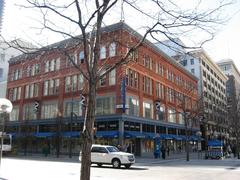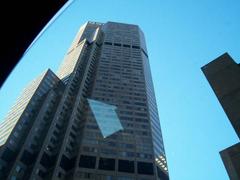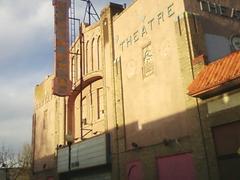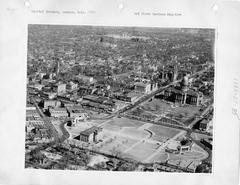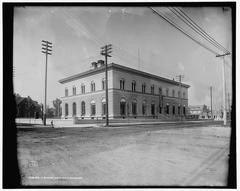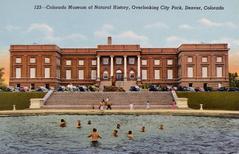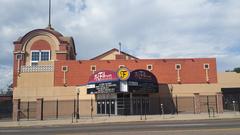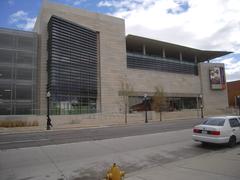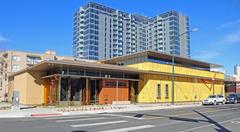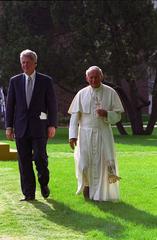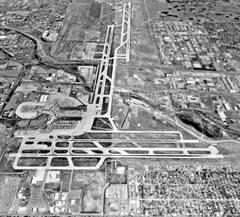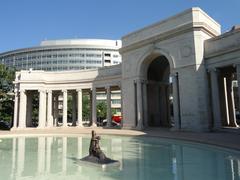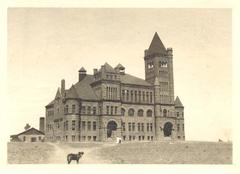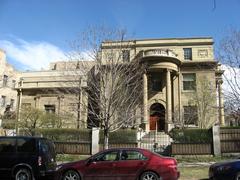
Fairmount Cemetery Denver: Visiting Hours, Tickets, and Guide to Historical Sites
Date: 04/07/2025
Introduction: Fairmount Cemetery’s Historical and Cultural Significance
Situated in Denver, Colorado, Fairmount Cemetery stands as a prominent symbol of the city’s historical, architectural, and natural legacy. Established in 1890, it is Denver’s second oldest continuously operating cemetery, encompassing 280 acres and serving as both a vast burial ground and Colorado’s largest arboretum. Renowned German landscape architect Reinhard Schuetze designed its picturesque setting, embodying the 19th-century rural cemetery movement with winding drives, diverse plantings, and open lawns. The grounds are home to significant architectural landmarks such as the Gothic Revival Little Ivy Chapel and the Fairmount Mausoleum, which features Colorado’s largest stained glass collection. Certified by the National Wildlife Federation as a wildlife sanctuary, Fairmount Cemetery is a haven for local fauna and migratory birds. Visitors can enjoy free daily access, guided tours, and special events organized by the Fairmount Heritage Foundation. Its proximity to other Denver landmarks, including Riverside Cemetery and the High Line Canal, further enhances its appeal as a destination for history, art, and nature enthusiasts (Fairmount Memorial; Denver Post; K99).
Table of Contents
- Introduction
- Founding and Early Development
- Landscape Architecture and Design
- Architectural Landmarks
- Notable Burials and Memorials
- Visiting Information: Hours, Tickets, and Accessibility
- Special Events and Guided Tours
- Artistic and Cultural Significance
- Preservation and Ongoing Relevance
- Frequently Asked Questions (FAQ)
- Visitor Tips and Nearby Attractions
- Conclusion and Resources
Founding and Early Development
Fairmount Cemetery was founded in 1890, following the closure of Mount Prospect Cemetery and the relocation of many burials. The first interment took place in 1891. Modeled after the park-like Mount Auburn Cemetery in Massachusetts, Fairmount was designed by Reinhard Schuetze, who planted more than 4,500 trees and shrubs in the first year. Today, the cemetery hosts over 145,000 interments and is both a historic landmark and Colorado’s largest arboretum (Denver Post).
Landscape Architecture and Design
Reflecting the rural cemetery movement, Fairmount features naturalistic landscaping, curving drives, tree-lined avenues, and open lawns. Its grounds provide a tranquil environment for remembrance and recreation, maintaining historic charm while integrating new crypts, mausolea, and chapels. The botanical features include a significant collection of antique roses and mature trees, supporting both the site’s ecological role and aesthetic beauty. Wildlife such as deer, foxes, and birds thrive within the grounds, especially due to the adjacent High Line Canal (K99).
Architectural Landmarks
Little Ivy Chapel
Erected in 1890, the Little Ivy Chapel is a prime example of 13th-century French Gothic Revival architecture, designed by Henry Ten Eyck Wendell. Notable for its flying buttresses and stained glass, it remains a favored site for ceremonies and historical tours.
Gate Lodge
Also completed in 1890 and designed by Wendell, the Gate Lodge originally functioned as the sexton’s residence and office. Its arched entryway marked the cemetery’s original entrance and now serves as the home of the Fairmount Heritage Foundation.
Fairmount Mausoleum
Completed in 1930 by Frederick E. Mountjoy and Francis W. Frewan, the mausoleum is renowned for housing over 15,000 interments and Colorado’s largest collection of stained glass art. Its construction during the Great Depression underscores the community’s commitment to dignified memorialization (Touristlink).
Notable Burials and Memorials
Fairmount Cemetery is the final resting place for numerous influential Coloradans, including:
- Dr. Florence Sabin: Medical researcher and public health advocate
- Helen Bonfils: Philanthropist and theater patron
- Charles Boettcher: Industrialist and philanthropist
- Frederick Gilmer Bonfils: Founder of The Denver Post
- Emily Griffith: Education pioneer
- Mary Elitch Long: Co-founder of Elitch Gardens
- Colonel John Chivington: Civil War figure
- Justina Ford: Colorado’s first Black female physician
- Mabel Costigan: Women’s rights leader
- Hyman Zadek Salomon: Denver’s first Jewish settler
The cemetery also honors veterans with dedicated sections for military burials, including Medal of Honor recipients and Japanese American World War II soldiers (PeopleLegacy; Denver Post).
Visiting Information: Hours, Tickets, and Accessibility
- Hours: Open daily from 8:00 AM to 5:00 PM; check for holiday variations.
- Admission: Free for self-guided visits. Guided tours and special events may require tickets, available through the Fairmount Heritage Foundation (Fairmount Memorial).
- Location: 430 S. Quebec St., Denver, CO 80247. Main entrance off Alameda Avenue.
- Accessibility: Wheelchair-accessible paths in primary areas. Contact the office for details on accessible routes.
- Parking: Ample on-site parking; public transportation options are limited—rideshare is recommended for non-drivers.
Special Events and Guided Tours
The Fairmount Heritage Foundation offers seasonal guided tours such as the General History Tour and themed walks focusing on pioneers, women’s achievements, military history, and funerary art. Annual community events include Veterans Day commemorations, rose garden festivals, and outdoor movie nights (Eventbrite; Mile High on the Cheap).
Artistic and Cultural Significance
Fairmount Cemetery is an open-air museum of funerary art. Sculptures and monuments by artists such as Robert Garrison, John Paulding, Arnold Ronnebeck, and Pompeo Coppini adorn the grounds. The collection of Victorian, Art Deco, and symbolic carvings reflects Denver’s evolving artistic and cultural values (Denver Post).
Arboretum, Botanical Features, and Wildlife Habitat
The cemetery’s arboretum includes over 3,800 trees and a nationally recognized collection of Old Garden Roses, with over 300 antique bushes and nearly 60 varieties. A designated wildlife habitat, Fairmount supports urban wildlife such as deer, coyotes, rabbits, and a variety of birds. A state-recognized wildlife viewing area offers opportunities for respectful observation (K99).
Pet Memorial Services
Fairmount’s Family Pet Loss Care program provides individual pet cremations, with plans for dedicated pet burial grounds, reflecting the community’s evolving needs (K99).
Visitor Amenities and Experiences
- Walking Trails: Extensive paths for self-guided exploration; downloadable maps and guides are available (Fairmount Memorial Information).
- Facilities: Restrooms in the mausoleum, benches throughout, and water fountains near the main entrance.
- Photography & Birdwatching: Permitted for personal use; the site is popular among photographers and birdwatchers.
- Events: Outdoor movie nights, garden tours, and community workshops are held seasonally (Mile High on the Cheap).
Visitor Etiquette and Guidelines
- Stay on designated paths and respect active services.
- Photography for personal use is allowed; commercial use requires permission.
- Pets on leashes are permitted; visitors should check the latest policies.
- Adhere to cemetery guidelines for decorations and flowers (Fairmount Memorial).
Accessibility and Safety Tips
- Most main paths and buildings are accessible, though older areas may be uneven.
- Dress in layers and use sun protection; Denver weather is variable.
- Bring water and bug spray for long or evening visits.
- For events, bring chairs or blankets (Denver by Foot).
Research and Genealogy Resources
A searchable online database with burial records assists genealogy and historical research. Staff and volunteers can help visitors locate graves and provide historical context (PeopleLegacy).
Frequently Asked Questions (FAQ)
Q: What are Fairmount Cemetery’s visiting hours?
A: Open daily from 8:00 AM to 5:00 PM (check for holiday changes).
Q: Is there an entry fee?
A: Admission is free; some tours/events may require tickets.
Q: Are guided tours available?
A: Yes, offered seasonally by the Fairmount Heritage Foundation.
Q: Is the cemetery accessible?
A: Most main areas are wheelchair accessible.
Q: Can I bring my pet?
A: Pets on leashes may be permitted; verify current policies.
Q: How do I get there via public transportation?
A: Limited options; rideshare or driving is recommended.
Visitor Tips and Nearby Attractions
- Wear comfortable shoes for walking.
- Explore nearby sites like Riverside Cemetery, Denver Botanic Gardens, and the High Line Canal Trail.
- Download maps and check event schedules before visiting.
- For detailed guides and audio tours, download the Audiala app.
Conclusion
Fairmount Cemetery is much more than a burial ground—it is a living museum that reflects Denver’s rich historical tapestry, artistic achievements, and natural beauty. Free admission, accessible facilities, and regular tours and events make it an inclusive and enriching destination for all. Whether you’re a history buff, architect, nature lover, or seeking quiet contemplation, Fairmount Cemetery offers a memorable experience. For up-to-date visitor information, consult the official website and the Fairmount Heritage Foundation.
References and Further Resources
- Fairmount Memorial Information and Resources
- Denver Post - Colorado’s Historic Graves
- This Colorado Cemetery is Now a Designated Wildlife Habitat - K99
- Touristlink - Fairmount Cemetery Overview
- Denver by Foot - Windsor Urban Hiking
- PeopleLegacy - Fairmount Cemetery
- Eventbrite - Fairmount Cemetery Events
- Mile High on the Cheap - Movie Nights

